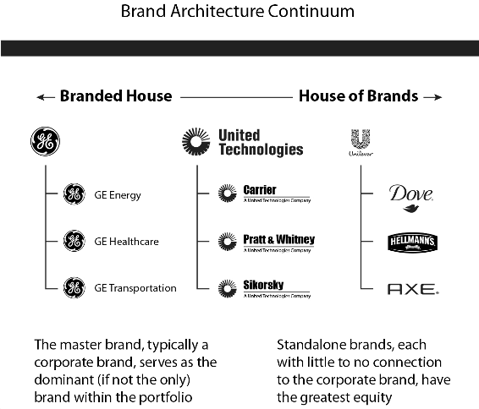
Is your brand overly complicated, perplexing, or just plain disorganized? Do your product and service offerings align with your customers’ needs? If not, a redesigned brand architecture might be in line.
What is Brand Architecture?
Brand portfolio strategy dictates the relationships brands should have with one another. The terms “brand portfolio strategy” and “brand architecture” are often used interchangeably, but the latter is a distinct, critical component of the former.
Brand architecture refers to how organizations structure their brands, products, and services — the relationships between a company’s brands. It is the framework in which brands relate to one another in terms of the overarching brand story you’re telling.
An organized, intuitive brand architecture is the surest way to bring your business’s product and service offerings into focus, enabling you to cross-promote them and gain control over how consumers perceive your brand.
In his books, Brand Leadership and Brand Portfolio Strategy, David Aaker
did an excellent job of proposing frameworks, structures, and guiding principles for managing large and complex brand portfolios. Perhaps most notably, Aaker’s work developed a continuum framework for brand portfolios that is still widely embraced today.
In Brand Leadership, Aaker refers to one end of the brand portfolio spectrum
as “branded house.” In this portfolio, the master brand (typically a corporate brand) acts as the dominant brand. In this scenario, descriptive sub-brands have little to no role in establishing market-facing equity or driving business results. General Electric is the premier example of a branded house.

At the opposite end of the spectrum is a “house of brands.” Here, independent, standalone brands have the greatest equity and represent the primary face to the market. Each has little or no connection to the corporate brand. P&G is an oft-used example of a house of brands, where brands like Tide, Dawn, Crest, and Febreze have greater consumer equity than the corporate brand. In a house of brands, independent brands in the portfolio are the primary conduit to customers.
The Practical Benefits of a Clear Brand Architecture
When your intentions are understandable and unmistakable in your customers' minds, managing their perception of your brand becomes a straightforward exercise. It enables them to navigate your offerings and appreciate their value. When customers know what you're about, it becomes easier for them to find what they're looking for despite the many options you're giving them.
Some of the scenarios this important strategic tool helps address include:
- Your customers aren't aware of or don't completely understand your entire portfolio of products and/or services
- One or more product/service infinitely out-performs the others, and you want to transfer some of its brand equity
- One or more product/service vastly under-performs, and you want to improve its visibility and/or reputation
- You've recently acquired a new brand and want to ensure you get the most out of integrating its products/services
- You're launching a new product/service and need to integrate it with your existing offerings
However, the benefits don't end here. A common misconception is that brand architecture is only relevant for large, complex organizations. But even small businesses notice measurable improvements in performance by better organizing their offerings.
Regardless of your company's size, effective brand architecture enables you to:
- Target the needs of specific customer segments
- Significantly reduce marketing costs by cross-promoting
- Clarify positioning and messaging
- Facilitate growth and bolster stakeholder confidence
- Enhance customer awareness
- Build and protect brand equity
Building a solid brand architecture can feel daunting, but our brand consultants have extensive experience helping clients organize their brands to align with their target audiences. Ultimately, it's about examining the nuances of your brand and deciding how to leverage each of its components to best benefit your organization. Keep in mind your goal is to create clarity from chaos and advance your ongoing branding efforts.
Recent Posts
Posts by Topics
- Brand Strategy (57)
- Brand Strategy Consulting (28)
- Brand Differentiation (27)
- Customer Experience (24)
- Brand Positioning (22)
- Marketing Strategy (9)
- Brand Extension Strategy (8)
- Customer Behavior (8)
- Brand Architecture Strategy (7)
- Brand Extension (7)
- Brand Growth (7)
- Brand Portfolio & Architecture (7)
- Brand Purpose (7)
- Brand Value Proposition (7)
- Brand Engagement (6)
- Brand Portfolio Strategy (6)
- Brand Storytelling (6)
- Rebranding Strategy (6)
- Brand Awareness (5)
- Brand Image (5)
- Branding (5)
- Rebranding (5)
- Technology (5)
- B2B Brand Strategy (4)
- Brand Experience (4)
- Value Proposition (4)
- Brand Extendibility (3)
- Brand Metrics (3)
- Brand Repositioning (3)
- Corporate Branding (3)
- Differentiation Strategy (3)
- Measurement & Metrics (3)
- Brand Engagement Strategy (2)
- Brand Portfolio (2)
- Brand Promise (2)
- Brand Voice (2)
- Digital Marketing (2)
- Digital and Brand Experience (2)
- Employee Brand Engagement (2)
- Brand Architecture (1)
- Brand Development (1)
- Brand Equity (1)
- Brand Identity (1)
- Brand Measurement (1)
- Brand Name (1)
- Brand Strategy Consultants (1)
- Brand Strategy Firms (1)
- Digital Strategy (1)
- Internal Branding (1)
- Messaging (1)


